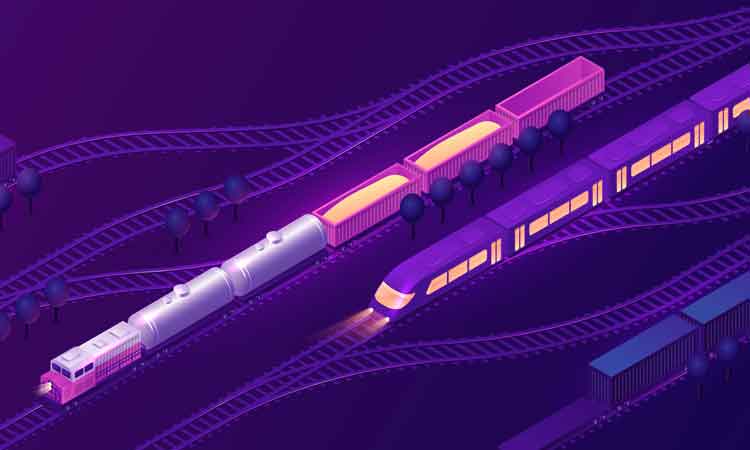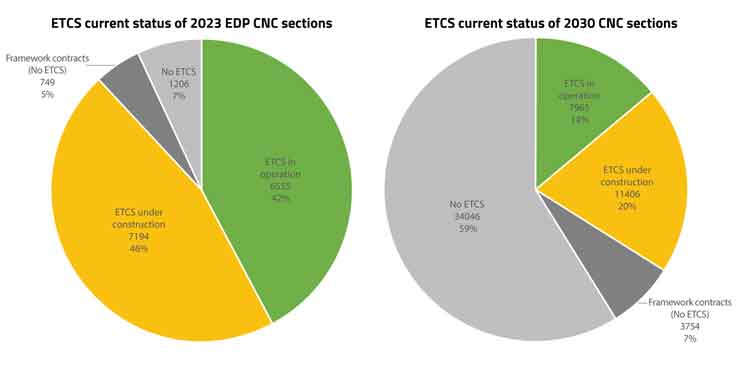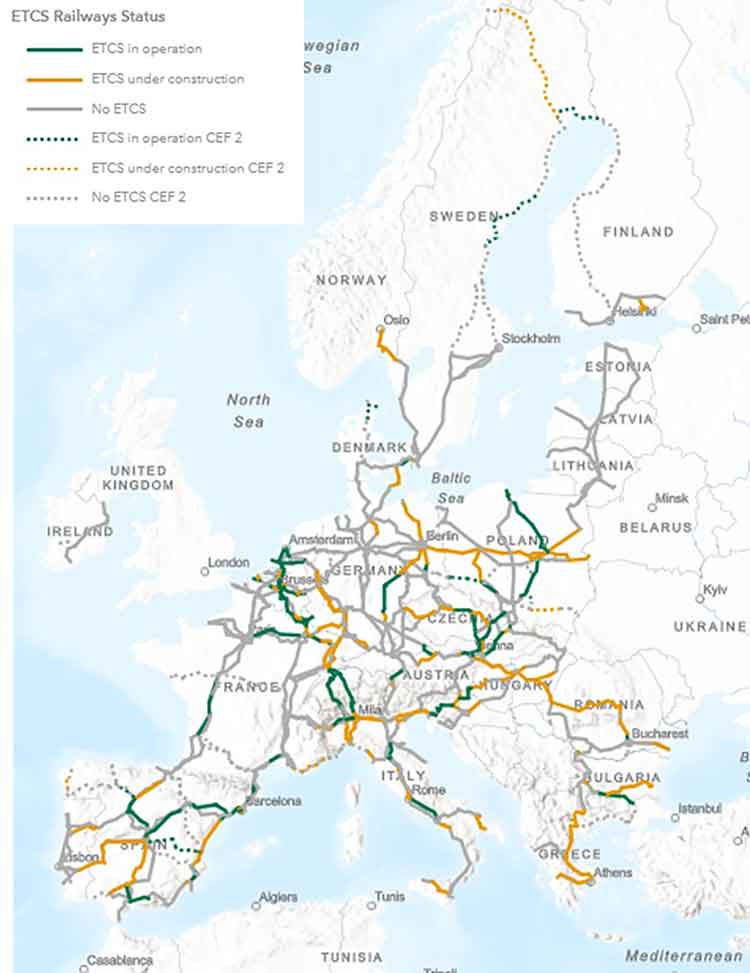Supporting on-board European ERTMS deployment
Posted: 21 October 2022 | Matthias Ruete | No comments yet
As the European Coordinator for ERTMS at the European Commission (EC), Matthias Ruete writes about the tipping point that Europe is reaching in regard to ERTMS implementation and the vicious cycle that must be broken in order to realise its maximum potential.


In mid-July 2022, I – as European Coordinator for ERTMS – rendered public my second work plan. Over the last few years, we have seen an acceleration in the policymaking process. The European Commission (EC), in its Green Deal and Sustainable and Smart Mobility Strategy (SSMS), laid out measures aimed at promoting a sustainable transport system. This was followed by, among others, the Fit for 55 packages in June 2021 and the December 2021 Transport package.
One of the more ambitious objectives for transport decarbonisation is to achieve significant growth in the modal share enjoyed by rail transport (both passenger and freight). To this end, a substantial increase in rail transport capacity is needed, which cannot be obtained without the widespread deployment of the European Rail Traffic Management System (ERTMS).
From 2022 onwards, both the revised CCS TSI and TEN-T Guidelines go through a negotiations process. The adoption of these legal acts in 2022 and 2023, respectively, will set new milestones for ERTMS deployment.
Reaching a tipping point
We have reached a wide consensus with most stakeholders to move up a gear in ERTMS deployment. ERTMS is increasingly seen as the European system replacing national (Class B) systems, rather than an add-on solution permitting interoperable operations.
We still experience a patchwork of approaches, but more and more Member States are taking the decision to opt for a network-wide deployment coupled with decommissioning of Class B systems; while some are only deploying on the core network; and very few Member States do not yet have robust plans to deploy ERTMS.
At this stage, I am nevertheless convinced that we are reaching a tipping point. The figures presented in my second work plan demonstrate this, but we need additional effort in terms of incentives and obligations.
The charts shown in Figure 1 highlight the current ETCS status of the CNC sections, expected according to the EDP by 2023 (15,700km) and the TEN-T Guidelines by 2030 (57,170km), including CEF 2 extension and excluding UK sections, and taking into consideration exemptions.


Figure 1: ETCS current status of CNC lengths expected according to TEN-T Guidelines and EDP by 2023 and by 2030.
The map shown in Figure 2 highlights the current status of ETCS deployment on the CNC. The dotted lines are those added to the CNC by the CEF 2 extension. Overall, based on known Member States’ plans, 69 per cent of the whole TEN-T will be equipped with ERTMS by 2040. The remaining 31 per cent include:
- New lines to be built, as they are supposed to be equipped with ERTMS
- Sections that are exempt from deployment (e.g., isolated networks)
- Sections to be equipped (both with Class B and without any train protection systems).
In this context, it is worth noting that, based on the existing national plans, by 2040, on-board Class B systems will be required only on less than 20 per cent of the current TEN-T Network.


Figure 2: ETCS deployment status in CNC in June 2022.
This estimate is both optimistic and conservative. On one hand, it assumes that Member States will deliver what they have planned in terms of ERTMS deployment on time. On the other, several Member States do not have plans going beyond 2030. As a result, additional sections could be expected by 2040 in those Member States.
In summary, the deployment plans of ERTMS on the TEN-T Core and Comprehensive Network by 2040 might look as shown in Figure 4 (countries that plan to achieve a network-wide ERTMS deployment by 2040 are highlighted in light green).


Figure 4: Reviewed ERTMS deployment plans by 2040 in EU27 + NO + CH.
The EC proposal for the revision of the TEN-T Guidelines sets out appropriate and robust incentives to reach this objective, or even more. ERTMS should be deployed not only on the core network, the new extended core network, and the comprehensive network, including in the urban nodes, but also on access routes to multimodal terminals. As a priority, we need to focus infrastructure deployment on existing gaps and close them as soon as possible. This will enable operations with ERTMS only and boost the business case for railway undertakings. ERTMS is increasingly seen as the European system replacing national (Class B) systems, rather than an add-on solution permitting interoperable operations.
ERTMS deployment should be coupled with a regulatory deadline for the decommissioning of Class B systems trackside. This decommissioning will bring about significant maintenance savings for infrastructure managers, as rolling out ERTMS and keeping additional signalling systems trackside for a prolonged period is costly and complicated.
Class B systems will become more and more costly and obsolete niche products with bespoke solutions. With the forthcoming standardisation, ERTMS will finally become a cheaper product with all of its advantages, including interoperability, reliability, capacity, and safety.
Class B systems should be removed in a coordinated way with a sufficient transitional period, allowing the railway undertakings to anticipate the changes and to adopt the most suitable migration strategy. Rolling stock must also be equipped with ERTMS in order to start the decommissioning of the Class B trackside.
The vicious circle of ERTMS
Even though trackside deployment is progressing rapidly, on-board deployment is going slower than expected, with new vehicles not being systematically fitted with ERTMS. Operators do not fit all of their newly purchased fleet as they do not see the need to invest when most of the lines in their area of operation are not yet equipped with ERTMS, and/or they can still use Class B systems. At the same time, some infrastructure managers delay deployment as no equipped rolling stock are available, which leads the industry into a vicious circle (see Figure 5). This situation might jeopardise trackside deployment or force infrastructure managers to keep two trackside systems for longer than initially planned.
Continuing this approach will undermine trackside deployment plans and the benefits of systemic ERTMS deployment overall. We need to make additional efforts to ensure an accelerated deployment of ERTMS on-board.
Railway undertakings, especially freight operators but also international passenger operators, cannot be left alone to equip their fleet. It is vital to provide improved support both at EU and a national level for the renewal of the fleet or the retrofitting of existing vehicles, whichever solution has a better benefit-cost ratio in a given context. In principle, retrofitting is several times more expensive than fitting. Thus, the preferred option should be fitting.
We need to implement the European on‑board strategy: stable and predictable budgets for retrofitting and upgrading; simplification of the authorisation process, in particular for serial vehicles; identification of bottlenecks for on-board deployment, and curb down regulatory exemptions for newly built locomotives. Some 20,000 locomotives and trainsets should reach 30 years of age or more by 2030. In many countries, the average age is already close to 40. Thus, we should make use of this opportunity to renew the rolling stock and give rise to a green and digital rail sector.
If we continue with the business-as-usual approach, only just above half of all vehicles will be equipped with ERTMS, whereas by 2030, we need 35,000.
If we do not impose a hard obligation to equip ERTMS on-board, we will still have rolling stock with only Class B systems on-board 50 years from now, thus, Class B trackside would have to be kept. As a result, we would have a dual on-board and dual trackside strategy for decades, which is costly and not very efficient.
Preserving EU support
ERTMS already benefits from a significant level of EU support. This support must be preserved and even increased to reach the targets set out in the TEN-T Guidelines. This will require considerable efforts, also in view of the economic repercussions of the Russian war in Ukraine. However, a large‑scale industrial project such as ERTMS can also give the right incentives for an economic relaunch, as already demonstrated by several Member States using the EU Next Generation funds to deal with the effects of the pandemic.
We should guarantee that evolution will take place in a non-disruptive way. This means that increasingly modular and broader standardisation approaches should be privileged and that future developments leave enough time to amortise current investments.
For rail to embrace digitalisation fully, the system will need to be more flexible and adaptable, with a ‘plug and play’ approach. This should drive the unit costs drastically down and create the conditions for ERTMS to become the backbone of the future digital rail in Europe.
The ultimate objective should be to make ERTMS the sole signalling system in Europe by using up-to-date technologies (DAC, 5G and satellite communications, satellite positioning, fully digitalised interlockings etc.).
ERTMS will also greatly improve safety, as well as increase the capacity of the network through traffic optimisation. We will thus have more trains on the existing infrastructure without the need to build new lines or additional tracks.
We need to make sure that for all this, we have the appropriate governance in place. With ERA, we now have a European ERTMS system authority. ERA prevents national ERTMS deployments from undermining interoperability and especially addresses the issue of implementation of additional national requirements.
The development of the System Pillar in Europe’s Rail Joint Undertaking (EU-Rail) should better prepare for future evolutions of ERTMS, and the proposed platform in the context of the TEN-T revision for ERTMS coordination should help to synchronise deployment in the Member States, and also function as an early warning mechanism for problems along the path to a European ERTMS system. I am going to anticipate the legal framework and convene informally the responsible authorities for national ERTMS deployment to the first meeting of the ERTMS Forum in October 2022.
Finally, as also pointed out in my first work plan; rail traffic management goes beyond what we currently have defined in our technical specifications.
The purpose of the focus on CCS+ is to take advantage of the fact that networks and Member States are migrating to CCS systems with radio based ERTMS. There is, therefore, an opportunity through the migration to move to a much more harmonised CCS+ European system beyond the scope currently defined in TSIs.
We need to make sure that we stay united in defining the other components of a European rail traffic management system, working with a single system authority, and building a common platform under the System Pillar of the EU-Rail to provide an agreed and well researched, detailed strategy for future evolutions.


Interested to know more about ERTMS developments?
Matthias Ruete will be moderating a panel discussion about signalling, train control and communications developments at Global Railway Review’s Digital Rail event, taking place at London’s Twickenham Stadium. Find out more and to register to attend here.
OUT NOW: The Definitive Guide to Rail’s Digital Future
The rail industry is undergoing a digital revolution, and you need to be ready. We have released our latest market report, “Track Insight: Digitalisation.”
This is not just another report; it’s your comprehensive guide to understanding and leveraging the profound technological shifts reshaping our industry. We move beyond the buzzwords to show you the tangible realities of AI, IoT, and advanced data analytics in rail.
Discover how to:
- Optimise operations and maintenance with real-time insights.
- Enhance passenger services through seamless, high-speed connectivity.
- Leverage technologies like LEO satellites to improve safety and efficiency.
Featuring expert analysis from leaders at Nomad Digital, Lucchini RS, Bentley Systems and more, this is a must-read for any rail professional.
Issue
Related topics
European Rail Traffic Management System (ERTMS), Signalling, Control & Communications, Sustainability/Decarbonisation







